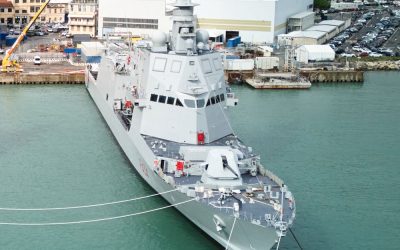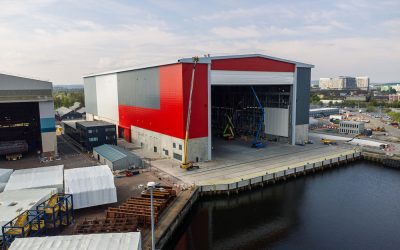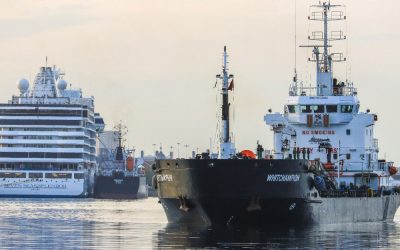Fincantieri, RINa and newcleo team up for nuclear-propulsion study
Although it’s unlikely to offer a short-term solution to shipping’s decarbonisation mission, the tantalising possibilities offered by nuclear power continue to attract a small but growing number of proponents among the industry’s forward thinkers.
In late July, Italian shipyard Fincantieri became the latest company to declare its interest with the announcement it had signed an agreement with compatriot classification society RINa and UK-headquartered startup newcleo to combine their expertise and innovation experience for a feasibility study for potential applications of its patented LFR (Lead-cooled Fast Reactor) technology in the shipping industry.
Unlike conventional nuclear fuel, which is made of uranium oxide, fast reactor technologies ‘burn’ mixed oxide (MOX) fuel generated from reprocessed nuclear waste and offer a superior conversion ratio. LFRs are among a range of emerging nuclear technologies known as Generation IV reactors and could potentially mean a ship could go from 10-15 years without the need for refuelling.
Stefano Buono, newcleo chairman and CEO, tells TNA: “It has always been our ambition to meet the growing commercial demand for clean electricity, and our Generation IV reactors were designed with this in mind. Our 30MWe reactor is highly versatile and therefore has the potential to power large shipping vessels, as well as islands and remote communities.
“We are very excited to be working with two major players in the shipping industry, Fincantieri and RINa, on this feasibility study, which marks a very promising step towards decarbonising this sector.”
Citing IMO’s 2050 net-zero targets, Buono explains that the 12-month agreement will draw on Fincantieri’s expertise in shipbuilding and RINa’s expertise in inspection, certification, ship classification and consulting engineering to assess the practicality of deploying newcleo reactors on vessels and identify any obstacles to achieving this.
Although Fincantieri is perhaps best known for its involvement in passenger shipbuilding, he stresses that the study is looking at the feasibility for shipping overall and application for commercial vessels and passenger ships are not currently being discussed. Rather the study will focus upon the practical considerations of marinising nuclear technology and identifying the challenges.
Strictly speaking, LFR technology isn’t anything new. During the 1970s two types of LFR were used onboard Soviet Alfa class submarines, offering the advantage of being significantly lighter than water-cooled reactors. However, historically there have been issues around the erosion and corrosion of the reactor’s internal parts, requiring the development of specialised materials.
Buono comments: “Lead can indeed have an important impact on materials, and this is one of our main areas of applied research. In addition to tuning the coolant speed and chemistry, we are in the process of designing ad hoc facilities to develop and test novel materials able to withstand the reactor conditions. We leverage on many years of research on this topic, also in collaboration with ENEA, and we are directly investing in setting up dedicated laboratories.
“Our demonstrator, a first nuclear prototype to be built in France, will ultimately give us the opportunity to test our design provisions and technological solutions, also on this topic.”
Addressing the inevitable concerns around safety, or potential weaponisation, Buono points out that (according to the World Nuclear Association) there are around 200 nuclear reactors at sea already, powering 160 ships, albeit many of these are for specialised applications such as submarines and icebreakers.
He adds: “Generation IV reactors in particular aim at implementing inherent safety and at increasing the proliferation resistance through design choices. They are the very latest in nuclear reactor design, taking the best elements of previous generations to create an optimal reactor.
“Not only are reactors safe in themselves, but they have the potential to improve safety in the shipping industry more broadly. Using nuclear power on ships would remove the risk of any fuel spills and therefore safeguard the marine ecosystem in the event of an accident.
“With newcleo’s design, in the event of a shipping accident, the liquid lead inside the reactor would solidify as it cools down in contact with the cold water, enclosing the reactor core in a solid casing, preventing any release of material in the environment.”
newcleo joins other would-be nuclear players such as UK-based Core Power, which is collaborating on a molten salt reactor (MSR) project that is expected to begin trials in 2025.
Elsewhere, Samsung Heavy Industries (SHI) recently announced it has partnered with Danish startup Seaborg Technologies and Korea Hydro & Nuclear Power to develop floating nuclear power plants utilising MSR technology. Since 2021, SHI has also been partnered with the Korea Atomic Energy Research Institute (KAERI) on a project that hopes to develop nuclear-powered vessels.






